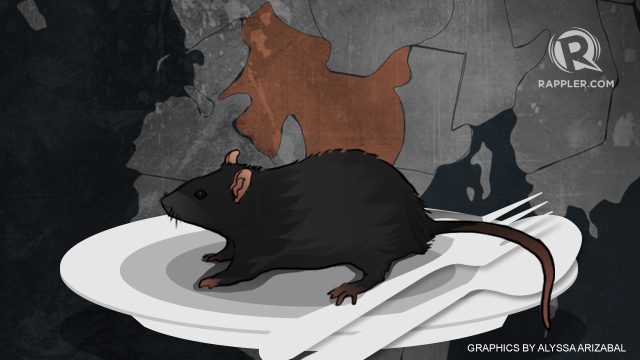SUMMARY
This is AI generated summarization, which may have errors. For context, always refer to the full article.

The hunger that is currently plaguing Central Mindanao was not the first time that farmers suffered from such depravity. It has always been there ever since settlers moved to these areas from the central and the northern Philippines after World War II.
But if it is El Niño that is responsible for the starvation, in the 1950s and early 1960s, it was the destruction of farmlands by rats, which caused the hardships in Cotabato. It was the Cebuano newspapers that first took notice of the pestilence. In the 1950s, rats infested the “imperial province of Cotabato” affecting 8% of rice production and losing the farms about U$55.3 million dollars.
Then Governor Udtog Matalam mentioned the following as being the most devastated: Koronadal, Tantangan, Tacurong, Sultan sa Barongis, Isulan, Ampatuan, Buluan, Datu Piang, Nuling, Tumbao, Pigcawayan, Libungan, Midsayap, Pikit, Pagalungan and the coastal towns of Kiamba, Maitum, Palembang, Kalamansig and Lebak. These towns still exist today, with some even reclassified into cities. Half a decade back they were settlement areas that were suffering the most.
It is human suffering that was the most dolorous.
The January 14, 1959, issue of Republic Daily stated that “[a]n estimated 200,000 people were starving today as a result of the rat scourge that has devastated a vast farming area in two provinces of Mindanao island in the southern Philippines. Officials estimated that 80% of this year’s crop in the heart of Cotabato province had been destroyed by ravaging bands of rats.”
The UNICEF Director, who visited the municipalities, returned to Cebu and described the devastation of over 2,400 square kilometers (240,000 hectares) farm lands this way: “The whole farming operation has been paralyzed,” he said. “And when I say all I mean all.” He added “[s]everal suicides had been reported in the ten most heavily stricken municipalities. The UNICEF Director who visited the area came back to report.” By the middle of 1959, agricultural officials estimated that over 86,000 families “stand to face famine” due to rat and locust infestation.
In the early 1960s, food shortages from rat infestation had spread to other provinces. This time, it was the Manila Times (February 3, 1960) that revealed that hunger was stalking towns and villages in Agusan, Bukidnon, Lanao del Sur, Zamboanga del Norte, Misamis Orient and “the sub-province of Camiguin.” In Davao, some 5,0000 “aboriginal tribesmen” were facing hunger after rats ravaged their farms (Mindanao Times, September 3, 1960).
The national government responded by sending various anti-rat weapons, including warfarin, a blood thinner for human heart patients that has been proven to be effective against rats, to the provinces and towns. The numbers of rats killed in Buluan town (in what is now Maguindanao province) totaled 1,123, 266 (The Daily Mirror, June 10, 1960).

Agricultural extension officials mobilized communities through the most innovative of actions. In Surigao, these officials were recommending that the provincial government set aside funds “for the purchase of rat tails as an incentive to farmers to kill or catch rodents in large quantity” (Manila Times, October 24, 1964). The Butuan city board set aside P12,000 to buy rat-tails “at P0.03 per tail.” This was its contribution to the province’s anti-rat campaign. (The Manila Times, October 31, 1964).
Women in the municipality of Guiwan in Zamboanga City led the way in collecting rat tails for the town’s beauty contests “where tails of dead rats and beetles were used for ballots by the lovely contestants.” The Daily Mirror (June 8, 1960) added: “The Philippine coconut administration in this city furnished cash prizes to the winners of the beauty tilt. The result was that 15,562 rat tails and 67,000 beetles were counted.” This “fad” of using rat tails as beauty contest ballots were replicated in Lebak, Cotabato a few years later (Manila Times, October 24, 1964).
Then there is rat cuisine. A recent news item by Business Mirror is about a farmer in South Cotabato are now hunting rats for food since the drought had worsened in the area. As incentive, the government also rewards Juanito Masangkay with rice for every rat-tail he presents to them.
Again this is not something new. In fact in the 1950s, central and northern Luzon towns boasted of eating field rats since they could not afford the other meats. They saw this also as a good way of ridding their farms of rodents.
Moreover, the farms also had the imprimatur of government. In fact, the latter strongly supported the idea of promoting rats as part of the regular fare. Here is R.S. Soriano’s last recommendation to the Bureau of Plant Industry in regards to how government can better run the anti-rat campaign:
“Rats as food – Still another method that also gives lasting control is to teach people to eat rats’ meat, especially the children who have not yet acquired any prejudice against the said meat. Once the people have come to like it, the chances are that there will no longer be a serious infestation for the people themselves will go after them, provided, of course, the rats are not bred or allowed to propagate for the purpose.” – Rappler.com
Add a comment
How does this make you feel?
There are no comments yet. Add your comment to start the conversation.